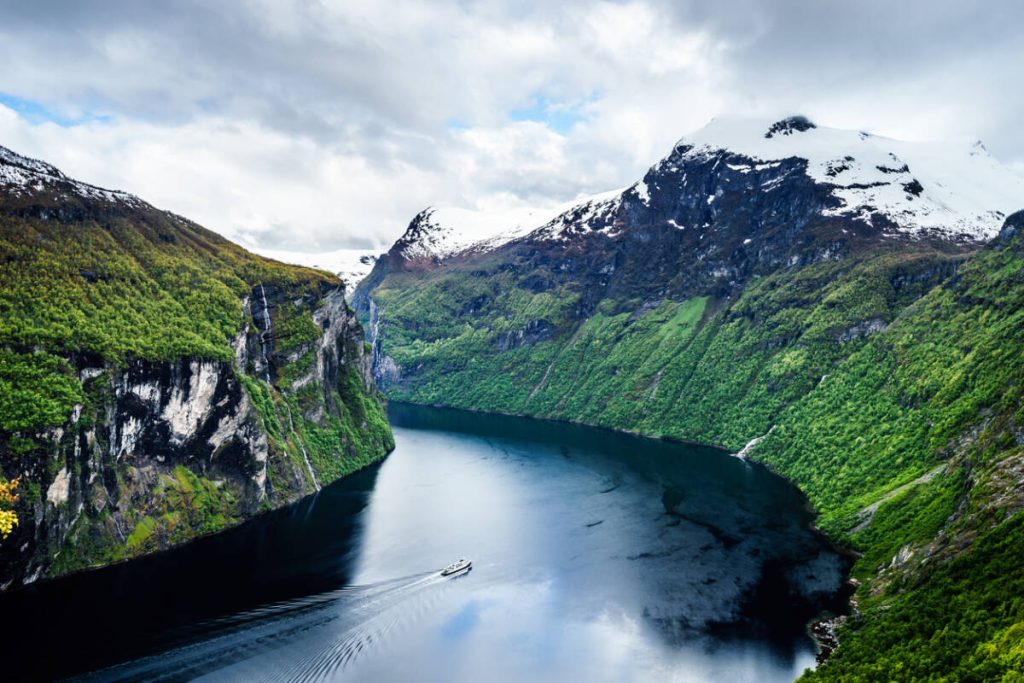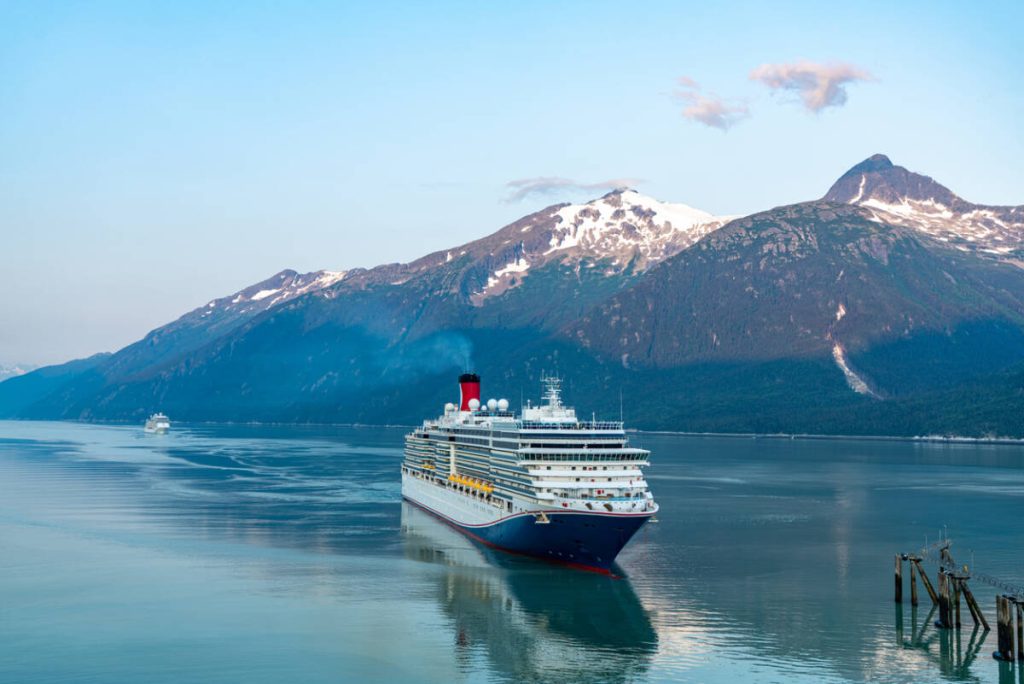Fairly or unfairly, the cruise industry has often been targeted for its contribution to global warming and pollution in its time.
However, things are changing. Environmental regulations are getting tighter. Cruise-goers are more conscious of how their travel affects our earth. And cruise lines are doing what they can to make their at-sea experiences more sustainable.
Below, we’ll take a look at what these lines are doing to clean up their acts and which are the most sustainable cruise lines you can travel with.
How much fuel does a cruise use?
On average, a large cruise ship can use up to 250 tonnes of fuel every day, which is around 80,000 gallons. It’s not uncommon for a cruise ship to use around 140 to 150 tons of fuel each day, eating up 30 to 50 gallons per mile travelled.
This is changing though. As the rest of this article will make clear, cruise lines are coming up with some incredible approaches to sustainability, all of which lets them do their bit for the environment.

What are cruise lines doing to become more sustainable?
Advanced water-waste technology
Contaminated water being released back into the ocean, either when sailing or in port, has been a major issue for cruise ships. This contaminated water features all sorts of nasties in it, affecting marine life – and us too.
To put a stop to this, certain cruise lines have now implemented advanced water-waste treatment technology, that treats any water entering their ships onboard before it’s safely released back into the ocean!
Better waste management
Cruise ships produce huge amounts of waste and rubbish each day. Seven tonnes of the stuff, in fact! But do cruise ships recycle? Thankfully, they do! We’re seeing more and more cruise lines reduce this number by using more recycled materials, and getting rid of single-use plastics on board.
So, it’s goodbye to things like plastic straws, stirrers and other wasteful packaging, and hello to things like new methods of removing waste, sorting materials more efficiently and donating reusable materials to communities that need it when their ships arrive in port. Even food can be recycled on board and turned into fish food for marine life to snack on!
Alternative power
Think about how much power is needed to keep a cruise ship, and all of its amenities onboard, up, and running. Can you imagine what the bills for lighting each room must look like? It’s probably not a pretty sight, which is why more and more cruise lines are turning to things like solar panels as a way of powering their vessels. Sure, we’re a long way from using these alternatives entirely, but every little helps of course!
Cleaner exhaust
25 million passengers sail on cruise ships every year. That’s a lot of to-ing and fro-ing. Which also means a lot of CO2 emissions over the course of those 12 months. To counteract this, more ships are using dual-fuel or hybrid engines.
Some lines have also been researching the use of biodegradable fuel in their ships, while exhaust cleaning systems are another option we’ve been seeing more of. They may be pricey, but they help to clean sulphur compounds from the ship’s engine exhaust – creating cleaner air for everyone on the planet.
Upgraded onboard technology
There’s a whole host of different ways cruise lines have been reducing their energy consumption. And crucially, they’ve been doing it without compromising on the service they provide to guests. Things like LED lighting, tinted windows, and more efficient appliances all add to the guest experience – without adding to a cruise line’s energy consumption.
More sustainable food sourcing
The food you eat onboard goes on a journey of its own, too. And often, that can add to the unsustainability of cruise ships too. But by looking at their supply chains and using more sustainable food products, cruise lines can combat this issue.
There are extra benefits too: guests can eat healthier meals, and cruise companies can forge better relationships with local farmers and communities in key ports. Even the cooking oil they use can be recycled and offloaded at port, where it’s then converted to bio-diesel fuel!
Improved ship design
It might cost an arm and a leg compared to some of the other methods we’ve mentioned, but altering the design of ships can make a huge difference, especially in the long term. A streamlined hull here, some growth-reducing paint there and fuel efficiency can be improved by up to 10%.

Which are the most sustainable cruise lines right now?
If reducing your contribution to climate change is up there with topping up your tan, exploring incredible ports and dining on incredible food during your holiday, then here’s our pick of the cruise lines doing what they can to make cruising more sustainable.
Carnival
Carnival’s eco-credentials are definitely on the strong side. Sister ships Mardi Gras and Celebration are both powered by LNG, a natural gas that reduces harmful particles that pollute the air and reduce the emission of greenhouse gases by up to 20%. That’s not all, the line will aim to achieve net carbon-neutral ship operations (i.e. any carbon released will be balanced by removing the same amount from the atmosphere) and zero-emissions by 2050!
Costa
Costa Toscana, the line’s latest flagship, is also powered by LNG, making it the line’s second ship to make the switch to the alternative fuel. The ship is also fitted with a range of environmental technology, allowing it to sail the seas with far lower exhaust gas emissions.
MSC Cruises
Along with MSC Euribia, another LNG-powered ship, MSC Cruises has made some serious waves with its sustainability efforts elsewhere. For starters, the line is a member of the Hydrogen Council, a global initiative made up of more than 100 companies increasing the use of hydrogen as fuel.
They’ve also turned what was an abandoned industrial facility in the Bahamas into Ocean Cay. Designated a Marine Protected Area by its government, Ocean Cay is now an incredible destination that the line’s guests can visit. And it’s more than just a tourist attraction, indigenous vegetation has returned to the island, coral reefs continue to grow, migrating birds are calling it home once again and there’s a new sea turtle protection plan in place too!
Virgin Voyages
You’d expect a cruise line from the mind of Richard Branson to be pretty progressive with its sustainability efforts, right? Well, you’d be right. The adults-only cruise line has gone above and beyond. Ever since it launched in 2021, the line’s direct emissions have been carbon neutral, while its first ship Scarlet Lady uses a fancy system to generate electricity from the wasted heat of engine cooling water.
What else? Single-use plastics have been banned, and there are no buffets to be found onboard either. It might sound like an odd move, but it’s helped to cut 225 tonnes of food waste per ship per year as a result. Each guest also gets their own water bottles to refill, while the seafood and coffee you can enjoy have both been sustainably sourced!
Royal Caribbean
Royal Caribbean are another cruise line with some sky-high sustainability goals: chiefly, net-zero emissions no later than 2050. The strategy, called Destination Net Zero, will involve creating more efficient ship hulls, improving energy efficiency, investing in a Kansas-based wind farm, developing alternative fuels, and reviewing its supply chains. The line also works with the World Wildlife Fund too, joining forces to reduce its environmental impact, make tourism more sustainable and support the work the WWF does to help conserve the ocean.
We hope you’ve found this look at eco-conscious cruising educational! To explore the ships we’ve mentioned here in more detail, head to our homepage and see what’s waiting for you in the not-too-distant future!

